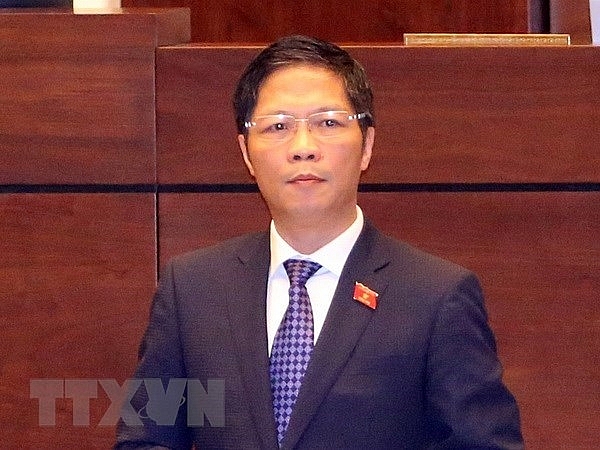CPTPP vital to sustainable development in Vietnam
 |
| Minister of Industry and Trade Tran Tuan Anh |
Therefore, economic sectors should prepare and take the initiative in economic restructuring in order to maximise the pact, which is scheduled to be inked in Chile on March 8 (local time) by ministers from its 11 member countries, Anh told VNA.
The minister said such sectors as garment-textiles, footwear, food processing, beverage, confectionery, tobacco, wine and beer will benefit most from the deal.
He cited a research jointly conducted by the World Bank (WB) and the research institute under the Ministry of Planning and Investment as saying that Vietnam’s GDP would be 1.1 per cent higher in 2030 thanks to the CPTPP.
| Like other member countries, Vietnam has committed to market opening and trade facilitation and liberalisation towards lifting non-tariff barriers. |
Like other member countries, Vietnam has committed to market opening and trade facilitation and liberalisation towards lifting non-tariff barriers, the minister said.
At the same time, the country will continue to streamline state management of market development, he said, stressing that through the agreement, competitiveness of the national economy as well as businesses will be likely improved.
Citing $36 billion in foreign direct investment (FDI) poured into Vietnam in 2017, Anh said the pact would lead to breakthroughs in the flow of investment into the country.
Domestic businesses, therefore, will have more resources to develop further and access technologies as well as quality human resources, the minister emphasised.
However, apart from opportunities, the agreement would pose challenges to both the business circle and people if less attention was paid to fulfilling integration commitments, the minister warned.
He cited lessons withdrawn from Vietnam’s joining the World Trade Organisation (WTO) and signing of the Bilateral Trade Agreement (BTA) with the US to clarify his views.
The official said a number of fields in the agriculture sector like sugarcane exploitation and sugar industry have remained slow in restructuring, as compared with other sectors like telecommunications, e-commerce, garments-textiles and footwear.
According to him, the Ministry of Industry and Trade has designed specific communications projects in order to help businesses and people grasp opportunities generated by the agreement.
The ministry will also submit an overall action plan to the government in preparation for the implementation of Vietnam’s integration commitments while reviewing its legal framework.
| The CPTPP is set to take effect in early 2019 after it is ratified by at least six member countries. Its member economies make up about 13 per cent of the global GDP. |
The CPTPP is set to take effect in early 2019 after it is ratified by at least six member countries. Its member economies make up about 13 per cent of the global GDP.
After the US withdrew from the Trans-Pacific Partnership (TPP), the predecessor of the CPTPP, in 2017, the remaining 11 countries (Australia, Brunei, Canada, Chile, Japan, Malaysia, Mexico, New Zealand, Peru, Singapore, and Vietnam) agreed to maintain the deal and rename it CPTPP.
They agreed on the revised content of the agreement on January 23, 2018.
On February 21, the full text of the CPTPP was announced, which is considered a sign showing that the 11 countries are ready to sign the agreement.
According to Reuters, more than 20 provisions of the CPTPP were suspended or changed compared to the TPP.
Earlier, US President Donald Trump said his country would consider re-entering the CPTPP if the US could get a better deal.
What the stars mean:
★ Poor ★ ★ Promising ★★★ Good ★★★★ Very good ★★★★★ Exceptional
Themes: CPTPP
Related Contents
Latest News
More News
- Vietnam’s green transition demands collective financial action (December 15, 2025 | 12:00)
- VIR workshop highlights capital and policy for sustainable development (December 15, 2025 | 11:00)
- National Assembly approves pilot mechanisms to accelerate major projects in Hanoi (December 12, 2025 | 11:29)
- Vietnam eases policy approval requirements, simplifies foreign and outbound investments (December 11, 2025 | 17:53)
- Unpacking new momentum in Vietnam’s M&A market (December 10, 2025 | 09:59)
- Forum honours outstanding M&A deals, strategies, and advisory firms (December 09, 2025 | 18:22)
- Vietnam enters defining phase of M&A growth (December 09, 2025 | 17:00)
- Vietnam’s M&A market opens new opportunities amid strong economic momentum (December 09, 2025 | 15:00)
- Vietnam M&A Forum 2025: new position, new momentum (December 09, 2025 | 14:30)
- FDI in Vietnam jumps on additional capital and share purchases (December 09, 2025 | 13:56)

 Tag:
Tag:


























 Mobile Version
Mobile Version